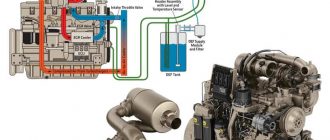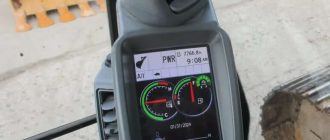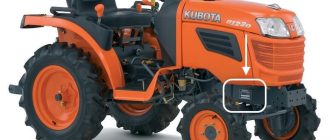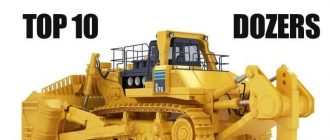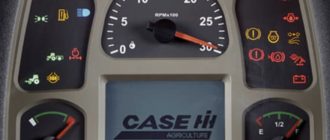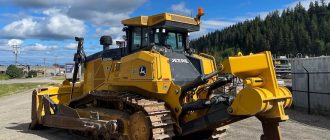- Examples of Kubota Tractor Model Decoding
- Kubota Tractor Model Name Format
- Kubota Tractor Series Prefix
- Engine (net), HP Numbers
- Chassis Numbers
- Suffix with Tractor Variation Codes (Optional)
- Kubota B Series Suffixes
- Kubota L Series Suffixes
- Kubota M Series Suffixes
- Difference Between Kubota L, B & M Series?
Kubota, a renowned manufacturer in the agricultural industry, has produced over 600 different tractor models throughout its operation. These models are organized into various series, totaling more than 70 different series. Each series encompasses tractors with varying power, wheelbases, and configurations, including options with or without cabs and ROPS.
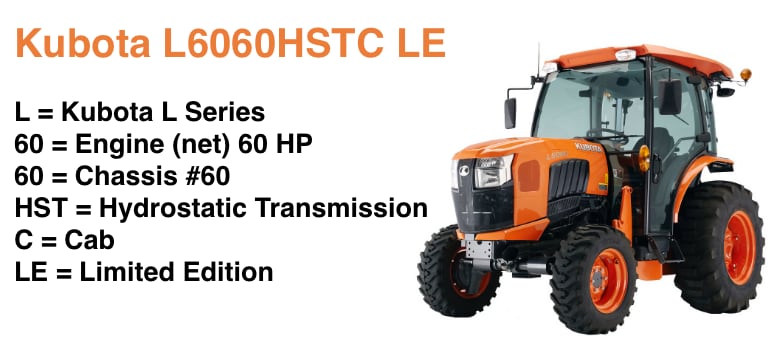
In this guide, we will delve into the coding system used to denote the unique characteristics of specific Kubota tractor models.
Examples of Kubota Tractor Model Decoding
Let’s break down some Kubota tractor model numbers.
- Kubota BX23S:
- “B”: Indicates it belongs to the B Series.
- “X”: Signifies it’s a compact or downsized version within the B Series lineup.
- “23”: Represents the horsepower rating. In this case – model with approximately 23 hp (real engine gross = 21.6 hp / 16.1 kW).
- “S”: Loader-backhoe tractor (Optional 3-Point hitch).
- Kubota LX3520DTN:
- “LX” + “20”: Designates it as part of the Kubota LX20N Series.
- “35”: Represents the horsepower rating. In this case – model with approximately 35 hp (real engine gross = 34.9 hp / 26 kW).
- “DT”: Dual traction (4WD).
- “N”: narrow tread (specialty, for orchard or vineyard)
- Kubota M5N-111 Cab:
- “M5N”: Indicates it belongs to the Kubota M5N Series.
- “111”: Represents the horsepower rating. In this case – model with 111 hp (real engine gross = 108.2 HP / 80.7 kW).
- “Cab”: Indicates the presence of a cab for operator comfort and protection.
Whether you’re a Kubota enthusiast or a prospective buyer, understanding these model numbers will provide valuable insights into the diverse range of tractors offered by Kubota (different series, configurations, and features). Here’s a breakdown of how to decipher Kubota tractor model numbers:
Kubota Tractor Model Name Format
Kubota Tractor Series Prefix
The model number typically starts with a series prefix that indicates the tractor’s general category or series. For example:
- “L” for L Series compact tractors.
- “B” for B Series sub-compact tractors.
- “B01” for B01 Series compact tractors.
- “M” for M Series heavy-duty tractors.
- “M4” for M4 Series utility ractors.
- “M40” for M4002 & M4003 Series utility tractors.
- “MX” for MX Series utility tractors.
- “MZ” for SynerZ Series utility tractors.
- “LX” for LX Series compact utility tractors.
- “GB” for GB Series sub-compact utility tractors.
- “GL” for GL Series compact utility tractors.
- “GM” for GM Series utility tractors.
- “GT” for GT Series compact utility tractors.
- etc.
Engine (net), HP Numbers
The next 2 digits (sometimes 3 digits if the engine power is more than 99 hp) represent the horsepower rating, although it can be somewhat misleading. Horsepower ratings are typically rounded, so the actual horsepower may be slightly lower. For instance, the Kubota MX6000 model, often presumed to have 60 horsepower, actually boasts 59.5 gross horsepower and 63.4 net horsepower. Despite this discrepancy, it provides a reasonably accurate estimation.
Chassis Numbers
The last 2 digits at the end of the model number signify the chassis, although this aspect lacks consistent patterns. Over the past 15 years, there has been a move towards standardization, but prior to that, it’s somewhat unpredictable.
For Kubota tractors less than 20 years old, the chassis numbers follow these general guidelines:
- Older B Series chassis numbers typically end in 20 or 50.
- Newer B Series chassis numbers often conclude with 00 or 01.
- BX Series chassis numbers may end in 50, 60, or 70.
- Grand L Series chassis numbers could be 30, 40, or 60.
- Standard L Series chassis numbers typically end in 00 or 01.
- MX Series chassis numbers usually conclude with 00.
- M Series chassis numbers might end in 60, X, or GX, where X and GX denote models with 100 hp or higher.
Please note that these identification codes apply to Kubota USA. Tractor identification numbers for Kubota series in other countries may vary slightly. For example, if you encounter a listing for a Kubota M5112 with 113.4 horsepower, it likely refers to a European model (M5002 Series).
Suffix with Tractor Variation Codes (Optional)
Certain models may end with a suffix denoting the trim level, special edition, or package designation. Examples include “C” for cab version, “E” for two-wheel drive (2WD), or “HST” for hydrostatic transmission.
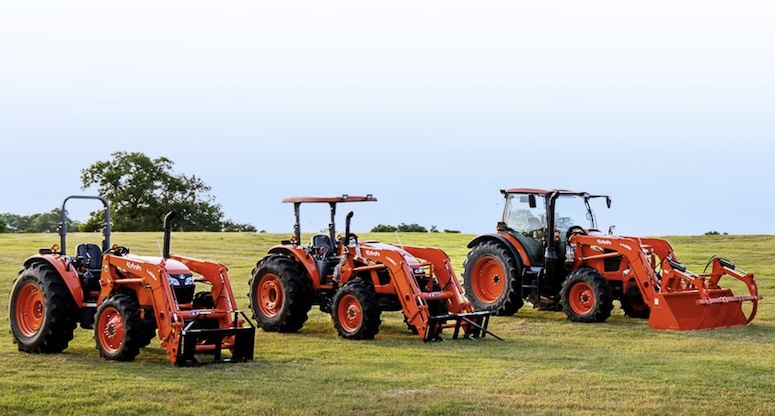
Naturally, the more specialized the tractor, the greater the potential for variations to be identified. While there may be some similarities, letter codes typically differ across different series. Furthermore, the position of the letters within the string can also hold significance in certain cases. Letters that appear at the end of the sequence after a dash may carry a different meaning. For example, TLB stands for tractor, loader, backhoe, while -T indicates that it’s a specialized tractor designed primarily for towing, commonly used in airports.
Several basic codes tend to remain consistent across all models:
- C – a cab model;
- D or DT – four-wheel drive (4WD);
- E or F – two-wheel drive (2WD);
- HST – hydrostatic transmission;
- TLB – tractor, loader, backhoe;
- H – high clearance;
- N – narrow tread, often used in orchards or vineyards;
- etc.
Kubota B Series Suffixes
| Letter Code | What it Means |
|---|---|
| D or DT | dual traction (4WD) |
| E | 2WD |
| HS | hydrostatic transmission |
| B | bi-speed turn |
| -T | tow tractor |
| T | turf tires |
| TL | tractor, loader |
| TLB | tractor, loader, backhoe |
| LB-T | loader, backhoe, with turf tires |
| LB-R | loader, backhoe, with R4 tires |
| R | R4 industrial tires |
| S | backhoe-loader tractor |
| V | loader valve |
Kubota L Series Suffixes
| Letter Code | What it Means |
|---|---|
| DT | dual traction (4WD), also sometimes written as double traction |
| DTC | dual traction (4WD), cab model |
| DTCCS | dual traction (4WD), cab model with creep speed |
| DTN | dual traction (4WD), narrow width specialty tractor |
| DTS | dual traction (4WD), power steering |
| DT-W | dual traction (4WD), wet clutch (Everclutch) |
| F | 2WD |
| FC | 2WD, live continuous running PTO |
| FS | 2WD, power steering |
| FSC | 2WD, live continuous running PTO, power steering |
| FST | fully synchronized transmission |
| GST | glide shift transmission |
| HC | high clearance |
| HDT | hydraulic shuttle, dual traction (4WD) |
| HF | hydraulic shuttle, 2WD |
| HSTC | hydrostatic feather step transmission, cab model |
| M | mechanical shuttle |
| SS | shuttle shift |
| W | wide tread for row crop applications |
| N | narrow tread (specialty, for orchard or vineyard) |
Kubota M Series Suffixes
| Letter Code | What it Means |
|---|---|
| DS | dual speed |
| C | cab model |
| DT | dual traction |
| M | mudder (specialty, for row crop or vegetable) |
| N | narrow tread (specialty, for orchard or vineyard) |
| -B | bi-speed turn |
| F | 2WD |
| -F | foldable ROPS |
| -CS | creep speed |
| H | 2WD |
| HC | 2WD, cab model OR high clearance |
| HD | hydraulic shuttle |
| L | low profile |
| OC | orchard model |
| S | synchro shuttle transmission |
| SU | special utility, 2WD |
| SD | swing shift transmission |
| CC | cab model with cold weather package |
| -R | rigid ROPS |
| -TF | turf special |
| W | wide row |
By understanding the structure and components of Kubota tractor model numbers, you can interpret the codes to identify the tractor’s series, features, and specifications. If you’re unsure about a particular model number or need more detailed information, referring to Kubota’s official documentation or consulting with a Kubota dealer can provide clarification.
Difference Between Kubota L, B & M Series?
There are three basic tractor series that distinguish Kubota equipment:
- B Series – 10-30 hp subcompact tractors;
- L Series – 25-65 hp compact tractors;
- M Series – 40-135 hp utility tractors.
The Kubota L, B, and M series are all popular lines of compact tractors designed for various agricultural, landscaping, and utility tasks.
In certain Kubota tractor models, the inclusion of an “X” within the model number signifies that the particular product is a downsized variant compared to its predecessor. For instance, the BX series is a scaled-down version within the B Series lineup, while the MX series represents a compact iteration within the M Series.
In summary, the main differences between the Kubota L, B, and M series tractors lie in their size, power, features, versatility, and price points. Choosing between the three depends on factors such as the intended use, budget, and specific requirements of the user.
